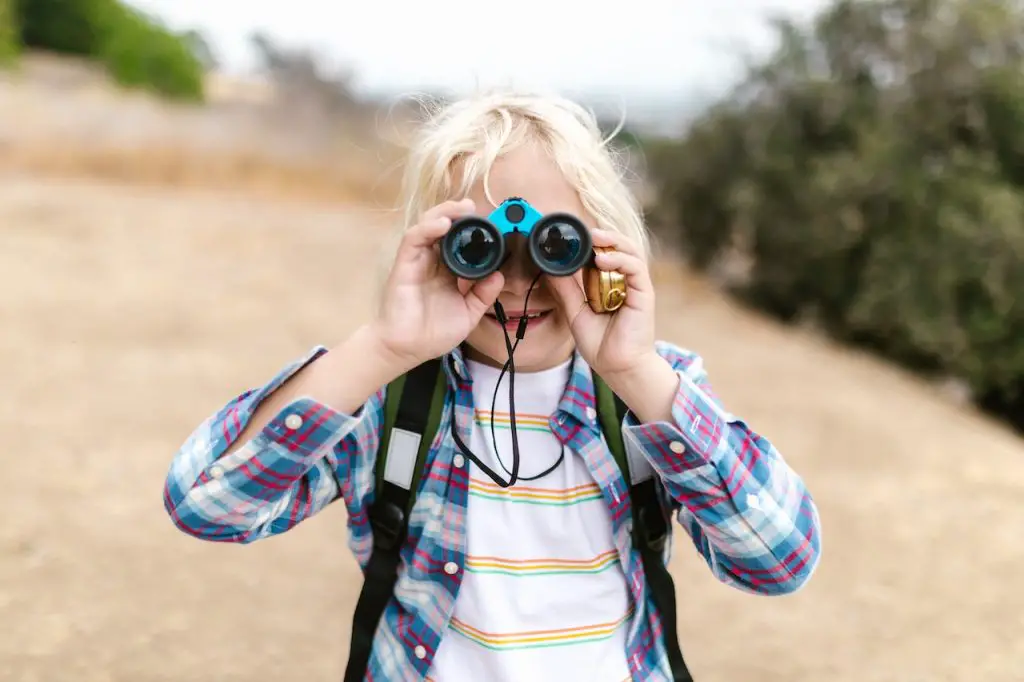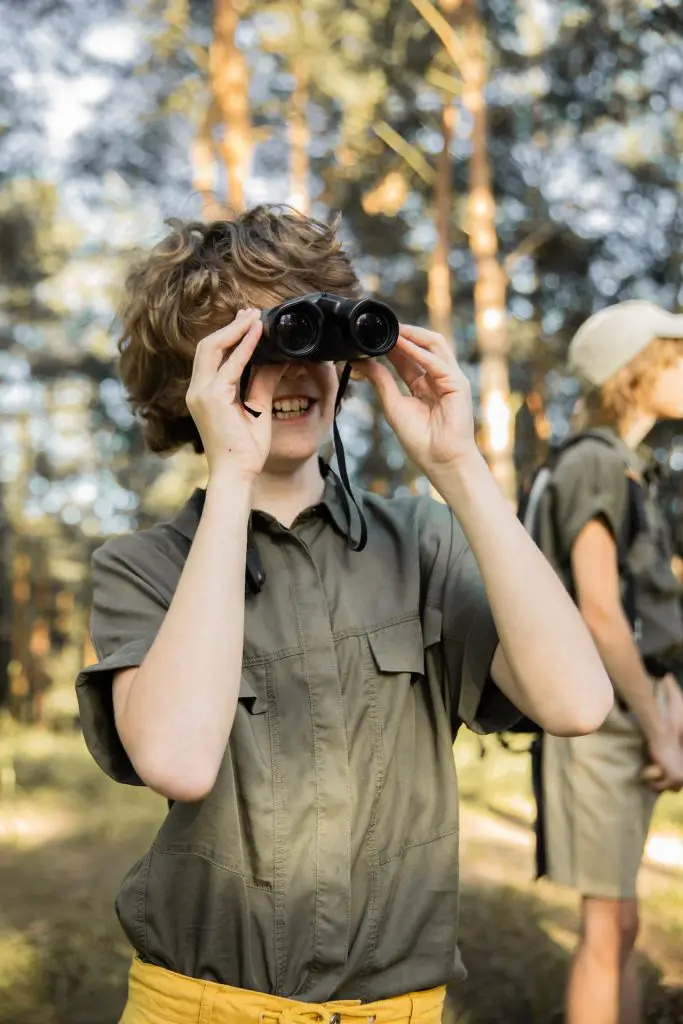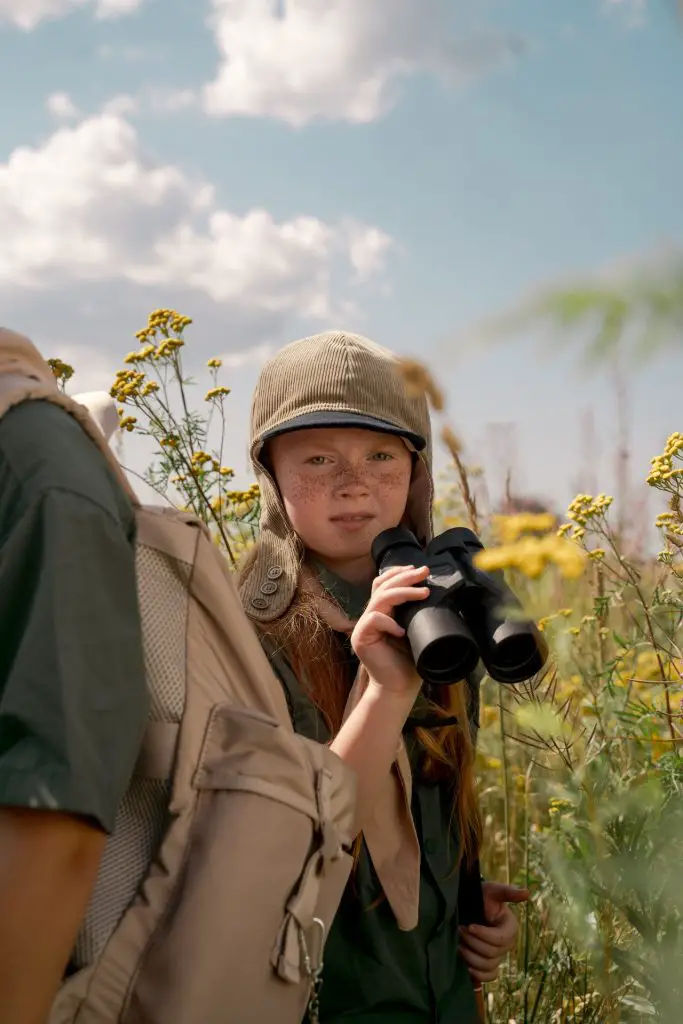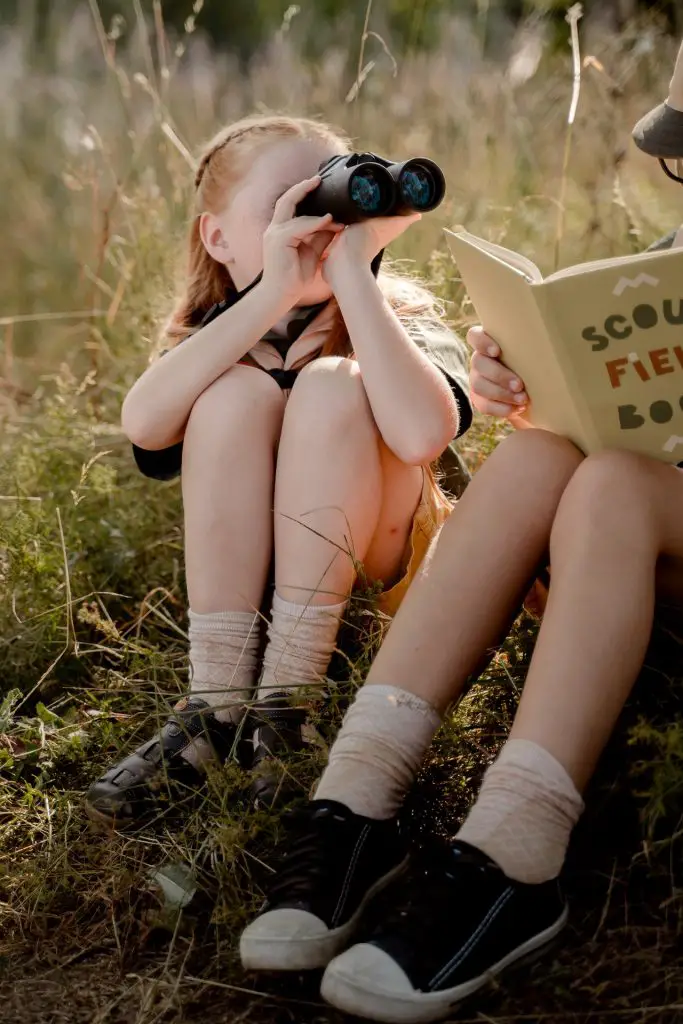Are Binoculars Safe For Kids?

Introducing children to the world of binoculars can be an exciting and educational experience.
However, ensuring their safety and fostering responsible behaviour is paramount.
Before allowing kids to use binoculars, there are several important considerations to keep in mind.
Let’s discuss different relevant considerations in this article.
At What Age Children Can Use Binoculars
Exactly which binoculars and what type of binoculars are suitable for your child depends on their age and experience in using them. Here’s a breakdown of options based on different age ranges:
Cheap Toys Numerous “children’s binoculars” flood the market, but most of them are cheap toys that provide a blurry view. For a better choice, consider the following options based on your child’s age and interests:
Binoculars Specifically Designed for Children (4 – 7 Years) These are more suitable for younger kids and come with features that match their age and abilities.
Standard Binoculars Suitable for Older Children & Teenagers (7 – 19 Years) For older kids, teenagers, and young adults, standard binoculars can be a better investment. They offer better optics and durability, which can last for years.

Binoculars Specifically Designed for Kids Be cautious when choosing binoculars specifically designed for kids. Some are mere toys, while others can be decent or great instruments.
Real Working Binoculars To ensure your child’s interest in using binoculars lasts, consider the following features when choosing:
- Decent Optics: Look for binoculars with good optical quality to provide clear and sharp views.
- Compact and Lightweight: Choose binoculars that are easy for your child to hold and carry.
- Durable Build: Opt for models with a robust build to withstand occasional drops.
- Appropriate Magnification: Lower magnification (e.g., 6x or 8x) is ideal for stable views.
- Wide Field of View: A wider field of view helps in locating subjects.
- Easy Focus: Binoculars with smooth and easy-to-adjust focus mechanisms are recommended.
- Good Eye Relief: Especially important for those who wear glasses.
Based on these factors, you can explore different options that suit your budget and your child’s age.
Proper Guidance and Supervision During Usage
While binoculars offer endless opportunities for exploration, children should be guided on how to use them correctly.
Parents and guardians should provide clear instructions on how to hold, focus, and adjust the binoculars.
Younger kids might need assistance in stabilizing the binoculars to prevent shaky views.
Supervision is especially important during outdoor activities, ensuring that kids are using the binoculars safely and responsibly.
What Constitute A good Safe Kids Binoculars
So, what constitutes the ideal binoculars for children? They must strike a balance between compactness and lightness for easy carrying, while also being robust enough to endure knocks and falls.
Simplicity in operation is vital to prevent kids from becoming frustrated.
Binoculars with rubber grips and rubberized bodies can handle occasional impacts or accidental drops. Waterproofing is a valuable feature for this age group.
Compact binoculars typically come at an affordable price point, making them replaceable if something unexpected occurs.
Despite their smaller size, compact binoculars often offer modest magnification, like 8x or 10x, coupled with a relatively small 25mm objective lens.
While this configuration might not be optimal for low-light observations, most kids won’t be exploring during twilight hours anyway.
Also Check: Best Kids Binoculars

Potential Safety Concerns For Kids Binoculars
While introducing kids to binoculars can be a fascinating adventure, it’s essential to address potential safety concerns to ensure their well-being during exploration.
Here are some safety considerations to keep in mind before handing over binoculars to children:
Risk of Eye Strain and Discomfort
Children’s eyes are still developing, and prolonged use of binoculars, especially those with high magnification, can lead to eye strain and discomfort.
It’s recommended that kids take regular breaks while using binoculars to prevent eyestrain. Encourage them to look away and focus on objects at varying distances to relax their eye muscles.
Proper Weight and Size Considerations for Children’s Comfort
Selecting binoculars that are lightweight and appropriately sized for children is crucial to their comfort and enjoyment.
Heavy binoculars can strain kids’ necks and shoulders, making the experience less enjoyable.
Opt for models specifically designed for children, which are lightweight and feature ergonomic designs that fit well in small hands.
Potential Choking Hazards with Small Parts or Straps
Some binocular models might come with small parts or straps that can pose choking hazards for young children.
Before handing over binoculars, ensure that they are free of any detachable parts that could be swallowed.
If the binoculars come with a neck strap, make sure it is properly attached and adjusted to avoid any risk of entanglement.
Tips for Safe Binocular Use for Kids
Introducing kids to the world of binoculars can be an exciting and educational experience. To ensure their safety while exploring, follow these practical tips for safe binocular use:
Selecting Lightweight and Durable Binoculars Designed for Children
When choosing binoculars for kids, prioritize models that are specifically designed for their small hands and developing eyes.
Look for lightweight materials that won’t strain their necks and comfortable grips that are easy to hold. Durable construction ensures that the binoculars can withstand the natural curiosity and occasional drops of young adventurers.
Teaching Proper Handling and Focusing Techniques
Educate kids on how to handle binoculars gently and responsibly. Show them how to hold binoculars with both hands to maintain stability and avoid dropping them.
Teach them how to adjust the focus wheel for clear views and how to use the eyecups for comfortable viewing, especially if they wear glasses.
Emphasize the importance of treating binoculars as delicate tools for observing the world around them.
Encouraging Breaks to Prevent Eye Strain During Extended Use
While binoculars offer fascinating insights, it’s crucial to encourage kids to take breaks to prevent eye strain.
Extended use can lead to discomfort and eye fatigue, affecting their overall experience.
Suggest that they look at objects without binoculars for a few minutes to relax their eyes before resuming their observation. This practice will keep their eyes refreshed and engaged.
Supervising and Engaging in Nature Exploration Together
Supervision is essential when kids are using binoculars, especially in outdoor environments.
Accompany them on their explorations and engage in nature observation together.
Encourage conversations about the animals, plants, and landscapes they’re viewing to enhance their understanding and foster a love for the outdoors.
Promoting Respectful Behavior Toward Wildlife
Teach kids the importance of respecting wildlife from a distance.
Binoculars allow them to observe animals without causing disturbances. Emphasize that getting too close to animals can stress them or even put them in danger.
Instill the values of responsible wildlife observation and conservation from an early age.

Engaging Activities with Binoculars for Kids
Engaging kids with binoculars through fun and educational activities can ignite their curiosity, encourage outdoor exploration, and cultivate a deeper appreciation for the world around them.
Here are some exciting activities that make the most of binoculars:
Bird Watching and Identifying Local Wildlife
Binoculars are an excellent tool for introducing kids to the world of bird watching.
Head to a nearby park, nature reserve, or even your backyard, and challenge your kids to spot and identify different bird species.
Provide them with a bird identification guidebook or use online resources to learn more about the birds they encounter.
This activity not only enhances observation skills but also teaches patience and attentiveness.
Educational Games and Challenges to Make Learning Fun
Create interactive games and challenges that involve binoculars to make learning exciting.
Play a scavenger hunt where kids use binoculars to spot specific leaves, flowers, or animal prints.
Challenge them to find hidden objects or clues in a designated area. You can also organize a “nature detective” game, where they use binoculars to investigate and solve nature-related mysteries.
Cloud Gazing and Astronomy
Binoculars can also be used to explore the skies during the day and night.
On clear days, encourage kids to use binoculars to examine cloud formations, identify shapes, and even spot birds soaring high above.
At night, introduce them to basic astronomy by using binoculars to observe the moon, planets, and constellations.
Nature Hikes and Observing Natural Habitats
Embark on nature hikes with your kids and encourage them to use binoculars to explore natural habitats up close.
Choose trails that lead through forests, wetlands, or meadows, and encourage them to focus on details such as animal tracks, insects, and plant life.
Use the binoculars to observe animals from a safe distance, reinforcing the idea of respecting their space.

Nature Journals and Sketching
Combine binocular use with artistic expression by encouraging kids to keep nature journals.
Provide them with sketchbooks and colored pencils, and have them use binoculars to focus on specific details they want to capture.
Whether it’s the intricate patterns on a butterfly’s wings or the texture of tree bark, this activity helps enhance observation skills and encourages creativity.
Science Experiments and Investigations
Use binoculars to spark scientific curiosity.
Observe insects at different stages of their life cycle, study the behavior of animals, or watch how plants change over time.
Encourage kids to ask questions, hypothesize, and record their observations, turning simple outdoor activities into valuable learning experiences.
By nurturing their curiosity and helping them develop a strong connection with nature, you’re laying the foundation for a lifelong appreciation for exploration and learning.
Conclusion
By choosing age-appropriate binocular models and providing proper guidance, parents and caregivers can create memorable and educational outdoor adventures that benefit children’s physical, cognitive, and emotional development.
